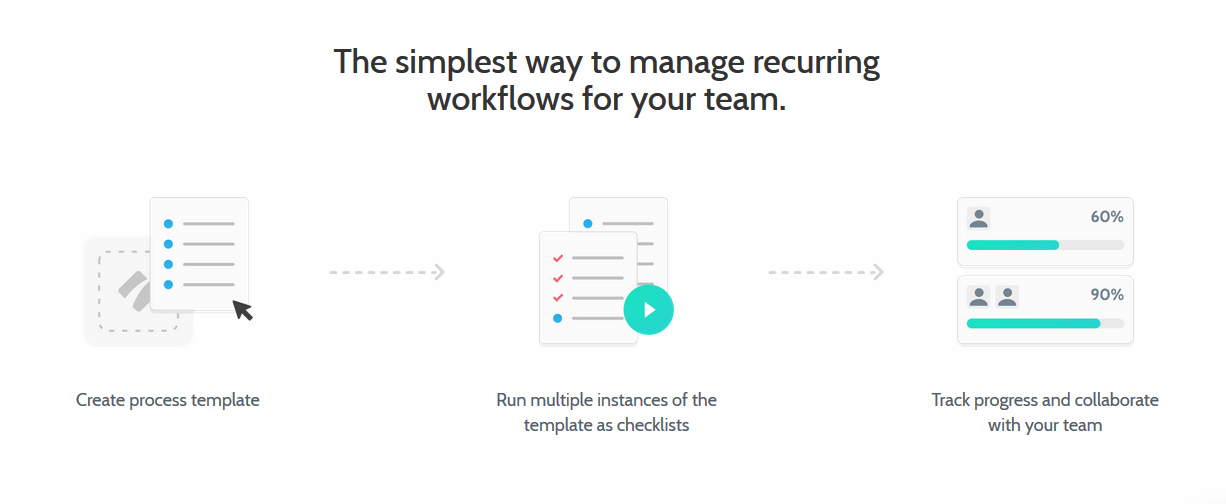
When it comes to managing what work gets done, we’re often faced with a choice: is this a project, a process, …or both? Project vs process, the age-old debate.
Different tasks need different approaches.
You need multiple techniques in your skillset and understanding the difference between projects and processes, and how this impacts on work, makes for a very useful tool.
In this Process Street article, we’ll look at:
- Project vs Process: What’s the difference?
- What is a process?
- What is a project?
- The principles of process management
- How projects can become processes
- Get started with process management today
Project vs Process: What’s the difference?
Project management and process management are very similar things.
They both help you get from A to B.
But they come at the problem from totally opposite angles.
Project management is about bending your company resources around a problem. Process management is about aligning company resources with a common problem.
Project management is flexible and changing; you’re facing new challenges and might require new ways to overcome them. Whereas, process management is more fixed and optimized; you’re taking known challenges and applying the most effective route to solving a problem.
At the extremes, a film director needs to be a great project manager as each film is different – a new location, a changed cast, using different tech. An accountant needs to be a great process manager as accounts need to be standardized and checked, the same way each time.
What is a project?
A project is broadly an accumulation of tasks which you need to accomplish to meet some kind of end goal.
Ari Meisel describes project management:
Project management is managing a lot of tasks that are going to help you achieve your goal.
Part of project management might also involve figuring out what all those tasks will be.
Maybe you’ve done this exact project before? Or maybe many similar projects? Or maybe you are discovering it for the first time?
It involves figuring out what needs to be done, and then carrying out that plan while being responsive to external factors.
As Meisel puts it, project management answers the question:
What needs to get done in order to get where we want to be?
What is a process?
A process differs from a project in that it answers a different question.
As Meisel describes, the question for processes should be:
How do things need to get done in order to get where we want to be?
This question already accepts that we know what the tasks are, and our real concern is the best way for tasks to get done.
A typical process management approach might look at 3 different aspects of this:
- In what order do tasks need to get done?
- How should those tasks get done?
- How do we align different tasks to fit into a working order?
So for a process, we’re taking a larger set of tasks which we’ve already done before and we’re focused on finding out what the best workflow is for that task and then executing that workflow as best as possible.
It’s largely about optimizing your way of working.
The principles of process management

Project management is a very useful discipline as you don’t always come across the same challenges every day. You have to be able to adapt to different circumstances and bring order to chaos.
Process management is about fine-tuning that order when you find it.
The rough stages of process management vary from commentator to commentator, but could be broken down into these 5 steps of our maturity model:
- Document your processes. Make sure you have written down what your processes are for all the different recurring workflows your team encounter.
- Follow your processes. Make sure you and your team are following these written processes so that work is getting done in the way the process specifies. You can use a tool like Process Street for this.
- Manage your processes. This is where you can build your operations around your processes. You can bring in specialist tools like Process Street and you can gather data on how effective different processes are.
- Optimize your processes. Use the information you have about how effective your processes are to begin to improve those processes carefully to achieve consistent performance increases.
- Integrate your processes. Now that your core business processes are effective and streamlined, you can link things together, integrate with other services or platforms, and truly systemize your whole business – everything accounted for via processes.
At Process Street, we advocate for agile business process management.
This means that you build your processes as you go, and make changes as you see fit. This is opposed to the traditional way of writing standard operating procedures where a team in an office would do nothing but write a big procedure manual.
We encourage teams to write their own processes and improve them iteratively over time.
We have an internal rule to always document any task you’re going to do more than twice.
How to get started with process management
I’m going to give you our super quick get-started guide, which I outline in more detail in this post about building business systems: How to Create Business Systems Even When You Have No Time.
Our research shows that nearly half of all companies who have signed up for process management software feel their biggest obstacle is not having enough time to create their processes. Imagine how big that number would be for all the other companies who aren’t taking process management so seriously!
So here’s a process for starting your processes:
- Pick one process. Decide its scope – where it starts and where it finishes. Pick an important process which you do regularly; the more regularly it is done, the more benefit you will see from it.
- Write it down. This could be scribbled on a tissue paper, you could be using a bullet journal for work, or you could put it straight into Process Street. It’s free to get started with Process Street, so dive straight in. Record the basic steps of the process; it could be 5 tasks, 10 tasks, or 50 tasks. Don’t try to be too detailed right now.
- Follow the process yourself. Next time you do the task, follow this process and make sure you’re doing every step.
- Add to the process. Take 5 minutes after you have finished the task to add some more steps to the process, or to add some important details to some tasks in the process.
- Give the process to your team. Ask either your whole team or just one member of your team to follow the process next time they do that task.
- Improve the process again. You can either ask your teammate to send you feedback on the process or you can let them improve the process themselves. Again, take 5 minutes for this – you do not need to block out an afternoon.
- Get your team to follow the process. Ask everyone to follow the process when they do this task. Ask everyone to send you some feedback on the process and any improvements they would recommend at the end of the week. 10 minutes on Friday to quickly provide that input.
- Make some more improvements and keep following the process. Make some tweaks based on your team’s feedback and then keep everyone following the process from now on.
Boom. Now your whole team is following a set standardized process for your most important core business process.
You are faced now with a choice:
- Find another process to improve
- Add further improvements to this first process.
The big win you could achieve by making further improvements to this process is to bring some automation into it.
If a process takes 5 hours to complete but you realize you could automate 20% of the process, then you could be saving an hour each time that process occurs.
If you want to read more about improving processes once you have them documented, here are some useful resources:
- Business Process Optimization: What, How, Why? (Free Templates)
- Business Process Analysis (Without the Jaw-Breaking Yawn)
- A Practical Guide to Increase Productivity with Process Mapping
- Process Improvement: Stop Bad Processes Killing Your Business
- The Ultimate Guide to Business Process Automation
- How to Use Visual Process Innovation to Make Your Startup More Efficient
- Business Process Reengineering: What to Do If Your Business Is Failing
- 50 Ways To Save Time & Money with Workflow Automation
- 50 Efficient Business Process Automation Examples You Can Steal
How projects can become processes
Now, with Process Street, almost all my duties are process based.
We have a process to manage our sprint, a process to plan our sprint, and a process to conduct our retrospective.
When a writer is assigned an article they have a process to follow; one process for content for our website, one for content for other sites, one for help site content, etc.
When a piece of content is completed, our content promotion team has a process to promote and push the content.
These processes are all linked where necessary and processes dictate the way all the teams within the department function, along with how they interact.
But I didn’t always work within such a process-oriented organization.
I came to Process Street from a software development studio. There was a fairly small team of us – about 10 – and I would do sales, account management, and project management.
We took pride in keeping staff deeply involved with the projects we were taking on. We received all kinds of projects to work on and each was different – from some government contracts, to developing mobile apps, to simple WordPress marketing sites, to peer-to-peer marketplaces. We did it all.
The problem we faced was that this artisan approach to varying tasks meant we couldn’t have a set process for our different projects. Projects then became slow and it was difficult to take multiple projects at the same time; it was hard to factor how the scope of work of one project would impact on another.
This created a stressful work environment where customers were often not happy and targets were not met. Our persistence at pushing forward with project management was not a wise economic choice.
But I believe a shift over to process management could have given us some great benefits.
There were certain projects we would get more than others – WordPress sites, ecommerce sites, and peer-to-peer marketplaces. If we had decided to only do those projects, then we could have turned each of those into a strong process.
- Having a process for those recurring tasks would have given more clarity to ourselves and the customer in what work needed to be done.
- Having a process for those projects would have allowed for them to be completed faster; making the customer happy and increasing our ROI.
- Having a process for different types of products would have enabled us to better predict how long a product would take to build and what our price estimation should be. This manages customer expectation while helping us understand our own capacity at any given moment and over time.
In other words, having recurring projects allows you to turn a project into a process and optimize the way it performs, providing benefits for yourself and the customer.
It also helps you align other business decisions: your sales team can focus on bringing in projects which are of most value to the business, not just whichever ones seem to offer money.
Get started with process management today
Process Street is superpowered checklists.
Process Street comes at process management in a way which makes it easy for your team to follow the process.
Diagrams and maps are good for understanding and analyzing a process but it needs to be actionable to provide business value. That’s why we structure processes around checklists.
Checklists are already a staple for getting work done and making sure it is standardized and all steps have been completed.
With Process Street, you create your process template and then run that template as a checklist. The template represents the process model and the checklist is a single instance of that model.

You can use features like checklist assignments, task assignments, and role assignments to delegate tasks to your team. Each of these features works a little differently to provide you with flexibility.
You can also use advanced features like stop tasks, dynamic due dates, and conditional logic to make a process better fit what a team member needs, and to help ensure adherence.
Each task in a Process Street checklist can have text, image, or video fields, and can have form fields for entry text, file uploads, and more.
Check it out by signing up for a free Process Street account and building your first template.
Do you work with processes or with projects? What do you think are the advantages of each? Let us know your thoughts in the comments below!







 Workflows
Workflows Forms
Forms Data Sets
Data Sets Pages
Pages Process AI
Process AI Automations
Automations Analytics
Analytics Apps
Apps Integrations
Integrations
 Property management
Property management
 Customer management
Customer management
 Human resources
Human resources
 Information technology
Information technology





Adam Henshall
I manage the content for Process Street and dabble in other projects inc language exchange app Idyoma on the side. Living in Sevilla in the south of Spain, my current hobby is learning Spanish! @adam_h_h on Twitter. Subscribe to my email newsletter here on Substack: Trust The Process. Or come join the conversation on Reddit at r/ProcessManagement.